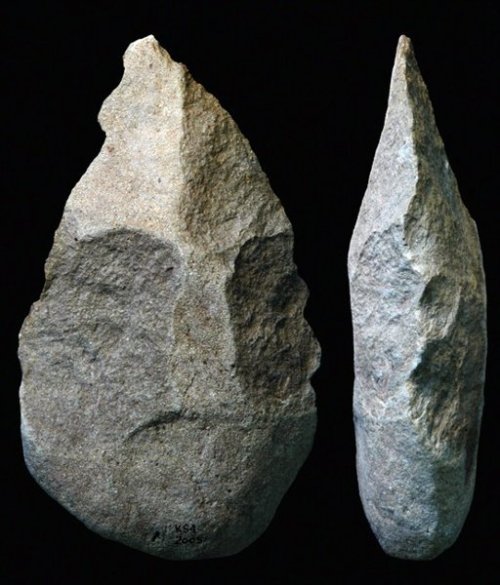LOS ANGELES (AP) — Ancient humans fashioned hand axes, cleavers and picks much earlier than believed, but didn‘t take the stone tools along when they left Africa, new research suggests.

A team from the United States and France made the findings after traveling to an archaeological site along the northwest shoreline of Kenya’s Lake Turkana. Two-faced blades and other large cutting tools had been previously excavated there along with primitive stone flakes.
Using a sophisticated technique to date the dirt, researchers calculated the age of the more advanced tools to be 1.76 million years old. That‘s older than similar stone-age artifacts in Ethiopia and Tanzania estimated to be between 1.4 and 1.6 million years old.
This suggests that prehistoric humans were involved in refined tool-making that required a higher level of thinking much earlier than thought. Unlike the simplest stone tools made from bashing rocks together, the early humans who shaped these more distinct objects planned the design and then created them.
This “required a good deal of forethought as well as dexterity to manufacture,” said paleoanthropologist Eric Delson at Lehman College in New York, who was not involved in the research.
Results of the study, led by Christopher Lepre of Rutgers University and Columbia University’s Lamont-Doherty Earth Observatory, appear in Thursday‘s issue of the journal Nature.
The stone tools, known collectively as Acheulian tools, are believed to be the handiwork of the human ancestor Homo erectus. The teardrop-shaped axes were “like a stone-age Leatherman or Swiss Army knife,” said New York University anthropologist Christian Tryon.
The axes were suited for butchering animals or chopping wood while the thicker picks were used for digging holes.
Homo erectus walked upright like modern humans, but possessed a flat skull, sloping forehead and a smaller brain. It emerged about 2 million years ago in Africa. Most researchers think Homo erectus was the first to fan out widely from Africa.
There’s archaeological evidence that the first to leave carried only a simple toolkit. The earliest sites recovered in Asia and Europe contain pebble tools and flakes, but no sign of Acheulian technology like hand axes.
Why that is “remains an open question,” said anthropologist Sally McBrearty of the University of Connecticut, who had no role in the research.
Theories abound. Some surmise that the early humans could not find the raw materials in their new settlement and lost the technology along the way. Others suggest they later returned to Africa where they developed hand axes.
NYU‘s Tryon, who was not part of the study, has a different thought. Perhaps the early populations who expanded out of Africa didn’t need advanced technology because there was less competition.
Early humans were “behaviorally flexible” and making hand axes “was something that they did as needed and abandoned when not needed,” Tryon said.
The latest work does little to settle the issue, but scientists now have identified the earliest known site in the world containing Acheulian tools.
Geologists collected about 150 samples of sediment from the site in 2007. To come up with an age, they used a technique known as paleomagnetic dating, which takes advantage of the flip-flop of Earth‘s magnetic field every several hundred thousand years.
The tools were not too far from where the bones of Turkana Boy — the most complete skeleton of a prehistoric human — were unearthed in 1984.
<한글기사>
인류의 석기사용, 생각보다 훨씬 오래돼
케냐서 176만년 전의 정교한 석기 발견
(서울=연합뉴스) 지금까지 발견된 가장 오래된 석기보다 35만년이나 앞선 약 180만년 전의 정교한 석기가 케냐에서 발견돼 인류가 아프리카를 떠난 과정에 대해 새 로운 연구가 필요할 것으로 보인다고 라이브사이언스 닷컴이 31일 보도했다.
프랑스와 미국 과학자들은 동아프리카 대지구대(大地溝帶)에 속하는 케냐의 투 르카나 호수 기슭에서 주먹도끼와 찍개 등 매우 정교하게 다듬어진 아슐리안 석기들 을 발견했으며 176만년 전이라는 연대를 확인했다고 네이처지 최신호에 발표했다.
아슐리안 석기는 아프리카를 떠나 유라시아로 건너온 인류가 사용했던 석기로 첫 발견지인 프랑스 생따슐 지방의 이름을 따 명명된 것이다.
연구진은 “아슐리안 주먹도끼는 호모 에렉투스 문화의 산물로 알려져 있으며 H.에렉투스가 등장한 연대는 약 180만 전, 또는 약 200만년 전으로 알려져 있다”면서 “많은 학자가 지금까지 최고(最古)의 것으로 알려진 160만~140만년 전 사이의 석기 보다 더 오래전의 석기들을 발견하기 고대해 왔다”고 말했다.
학자들은 이전에도 이 지역의 발굴지 5곳에서 각각 정교함에 다양한 차이를 보 이는 이보다 오래된 올도완 석기들을 발굴했다.
올도완 석기들은 그다지 많은 공이 들지 않은 것으로 그저 돌 두 개를 서로 마 주쳐 날카로운 날이 되는대로 만들어진 석기라고 할 수 있다고 연구진은 설명했다.
그러나 아슐리안 석기는 타원형으로 잘 다듬어진 형태를 갖고 있는데 이는 H.에 렉투스가 도구의 모양과 크기를 처음부터 염두에 두고 만들어냈음을 시사하는 것이다.
연구진은 고대인류가 주먹도끼의 날로 얼룩말이나 기린을 도살하고 가죽에서 살 을 발라내고 뼈를 갈랐을 것으로 보이며 땅에서 채소를 캐내는 도구로 사용했을 가능성도 있다고 말했다.
지금까지의 자료를 보면 176만년 전 아프리카에는 도구를 사용하는 최소한 두 종류의 호미니드(사람과<科> 영장류)가 존재했던 것으로 보인다.
이 가운데 H.에렉투스는 아슐리안 도구 기술을 사용했고 보다 원시적인 호모 하 빌리스는 올도완 석기를 사용했을 것으로 추측된다.
그러나 이들 도구가 어떤 경로로 아프리카를 떠났는지는 아직도 의문에 싸여 있다.
아슐 문화와 그 도구들은 약 100만년 전에야 유럽에 도착한 것으로 보이며 H.에 렉투스는 약 150만년 전 유럽에 정착하게 된 것으로 보인다.
연구진은 이것이 두 가지 사실을 시사한다고 밝혔다.
하나는 유럽에 이주한 H.에렉투스 집단이 아슐리안 도구제작 기술을 갖고 있지 않았을 가능성이고 또 하나는 아슐리안 석기를 개발한 것이 애초에 H.에렉투스가 아 닐 가능성이다.
연구진은 H.하빌리스 같은 다른 호미니드가 처음 아슐리안 석기들을 개발했고 그 기술이 나중에 H.에렉투스에까지 퍼졌을 가능성도 있는 것으로 보고 있다.



















![[Today’s K-pop] BTS pop-up event to come to Seoul](http://res.heraldm.com/phpwas/restmb_idxmake.php?idx=642&simg=/content/image/2024/04/17/20240417050734_0.jpg&u=)